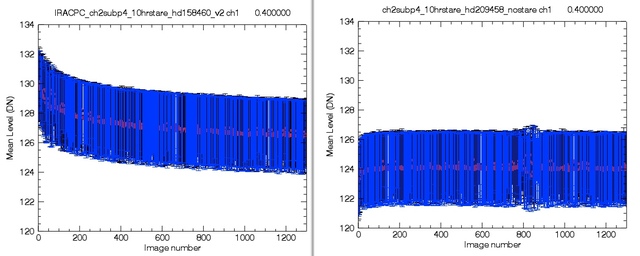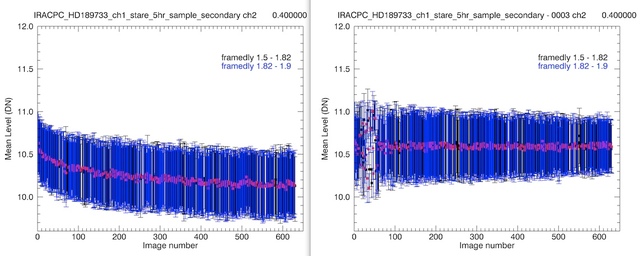IRAC High Precision Photometry
Observations taken with a dither pattern will have a different bias level and pattern than observations taken in staring mode. This is because the bias is sensitively dependent on both the time between observations, and all previous observations. Dither pattern is important because the frame delay times are determined by the slew times inside of that pattern. The delay time is at least 7 seconds between pointings for dithered observations (includes slewing), but only about 2 seconds between successive staring frames, and within a 64 frame subarray, there will be 0 frame delay.
This is relevant to light curve staring mode photometry because the IRAC pipeline uses an image of the dark current which is made from dithered observations to remove the bias pattern from all observations, regardless of dithering or staring. Because IRAC does not use a shutter, we generate an image of the dark current by making weekly observations of a relatively blank region of the sky at the north ecliptic pole (NEP). When this dithered dark observation is used to correct a staring mode observation, there is the potential for a low level bias pattern residual in the dataset. This residual pattern could effect the photometry of staring mode observations. The inaccuracy in the bias level (as opposed to pattern) does not matter for aperture photometry.
IRAC data does have a change in inter-frame delay times over the 64 subframes of a single bcd, since the first sub-frame will have a longer delay time than the subsequent sub-frames. We also see preliminary evidence in archival data of a bias level change over the course of long (5-10 hour) stares (see below), which leaves open the possibility that there is also a bias pattern change on those timescales.
To explore these bias patterns, the IRAC team has designed and executed a first set of test observations of the NEP field with staring mode observations. Our goal with these observations is to measure the difference between dithered and staring mode darks at the frame times which are useful for high precision staring mode photometry, and determine the necessity and feasibility of using staring mode darks on staring mode observations. If necessary, we would then create a new set of "labdarks" for the Warm IRAC pipeline which will automatically correct each image for the bias pattern according to the length of the delay time.
Bias level changes on long-timescales (~10hours). Bias level as a function of time appears to not be repeatable from AOR to AOR. The dataset used to make these plots are 10 serendipitous staring mode AORs (5 in each channel, 0.4s) in the off-field position, so theoretically empty of stars, although there are some stars in these observations. This bias change is not dependent on frame delay (aka all frame delays show the change as a function of time). From these 5 AORs per channel, the maximum deviation is ~2 DN in ch1 and ~0.5 DN in ch2. These are binned over the whole BCD, so each point includes the mean from all 64 subframes. Only one amplifier is shown. Blue and black points show the different frame delays, for which there is no correlation with the shape of the long-timescale change. Here we show 2 plots for each channel to demonstrate the range of level changes.


Bias Level in DN as a function of time